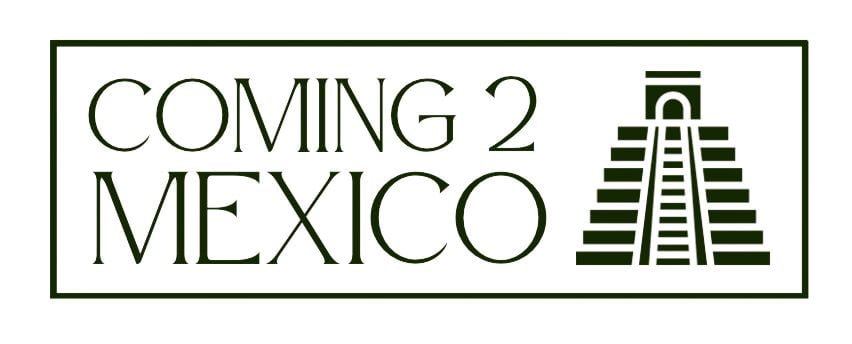The Travesía Sagrada Maya, an evocative revival of one of the most significant rituals of the ancient Maya, takes place every year on the third weekend in May. Presented in the vibrant surroundings of Xcaret Park on the shores of Mexico’s Riviera Maya, this event transcends time, linking the present to the mystical past through a daring canoe journey from the mainland to the sacred island of Cozumel.
The starting point of the Sacred Mayan crossing is Bahía Dos Playas in Xcaret, the Riviera Maya’s emblematic eco-archaeological park. In this arduous journey, the canoeros will cover a distance of over 30 kilometers to reach the protected cove in Cozumel’s Chankanaab Park. Here they will honor and ask for blessings from the oracle of the Goddess of the moon, Diosa Ixchel.
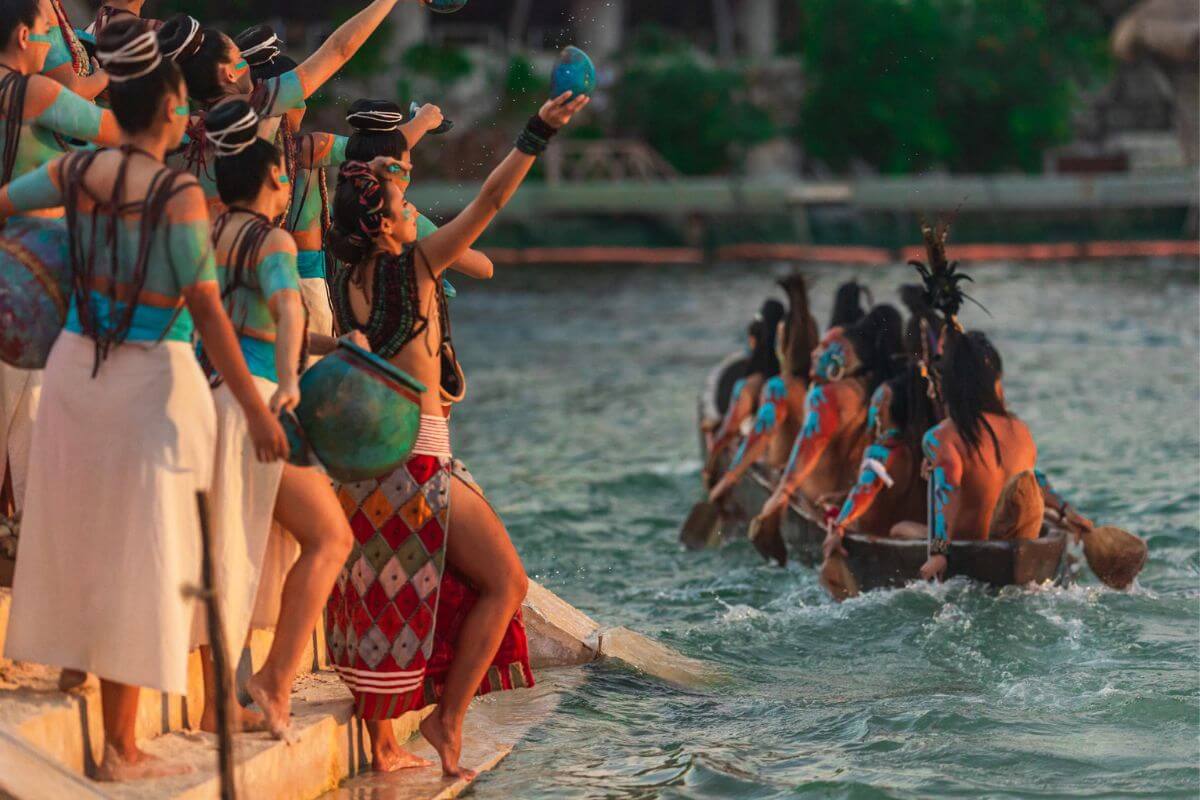
Lucky participants train for months to navigate the ancient sea route once traveled by Mayan oarsmen to honor the Goddess Ixchel, the revered Maya Goddess of fertility. This pilgrimage is not merely a test of physical endurance but a profound homage to the spiritual and cultural heritage of the Mayan civilization, offering a unique glimpse into the fascinating traditions that have shaped this region.
Contents
The Historical Background
The Travesia Sagrada Maya or Sacred Mayan Journey has its roots deeply embedded in the spiritual and daily life of the ancient Maya civilization. This pilgrimage, originally undertaken to connect with the divine, involved a perilous canoe voyage across the Caribbean Sea from the trading post of P’olé (now the location of Xcaret Park in Playa del Carmen) to the shrine of Ixchel in Chankanaab Park on the island of Cozumel. The purpose of this ancient tradition was to seek the blessings of Ixchel, drawing pilgrims who sought special favors and her blessing for bountiful harvests and good health.
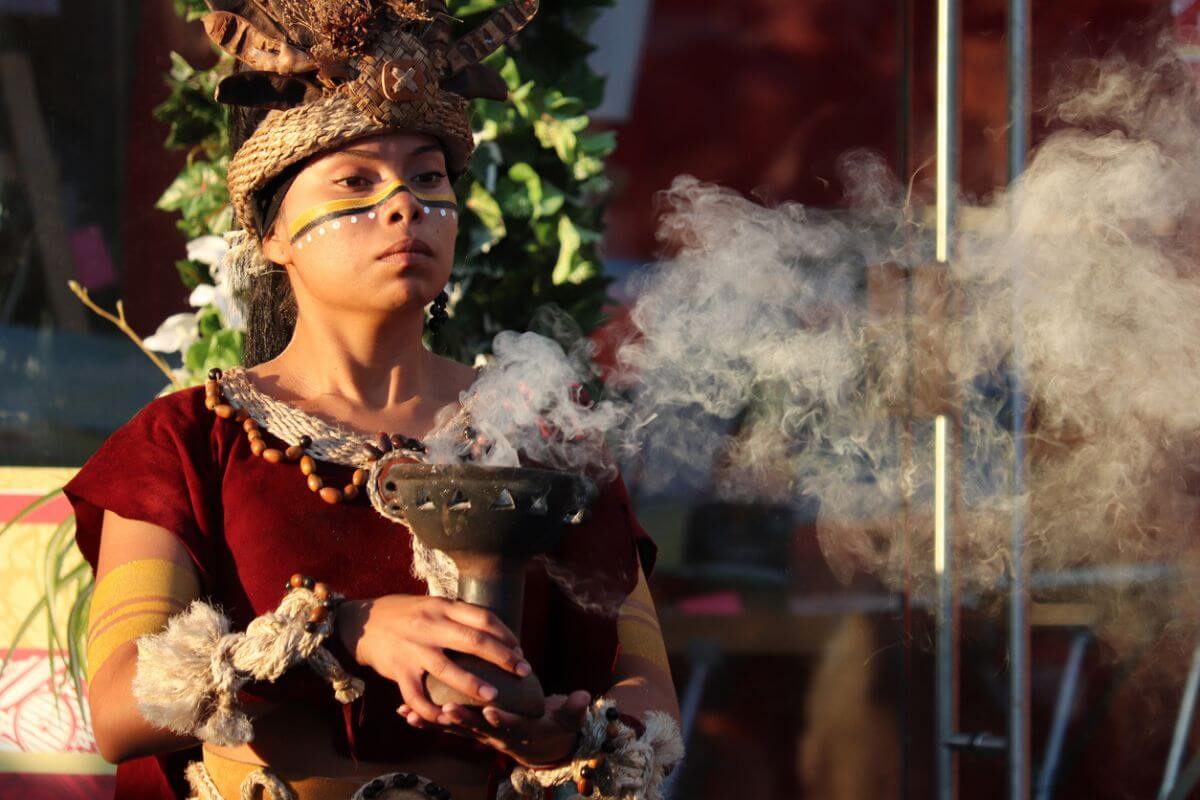
This route from P’olé to Cuzamil (Cozumel) was not merely a physical journey but a spiritual expedition reinforcing social and religious ties among the communities of the zona Maya on the mainland and the island. The crossing underscored the Mayans’ deep connection to the sea as a pathway to the divine and as a vital resource that sustained their civilization. Today, the reenactment of this sacred voyage serves as a powerful reminder of the endurance of Mayan culture, bridging the ancient past with contemporary efforts to preserve these timeless traditions.
The Revival of the Sacred Mayan Journey
The Travesía Sagrada Maya was resurrected by Xcaret Park as a tribute to the rich cultural heritage of the Maya civilization. This modern enactment began in 2006 and has since evolved into one of Mexico’s most significant cultural events, capturing the imagination of a global audience. Each year, participants, the canoeros and canoeras, don traditional Mayan garments and decorate their skin with coral and turquoise pigments, recreating the ancient Mayans’ preparations for their spiritual journey.

Xcaret’s meticulous attention to authenticity—from the construction of the canoes based on ancient designs to the replication of ceremonial attire and practices—ensures that the event is not just a spectacle but a faithful homage to Maya traditions. This dedication to authenticity helps bridge the past with the present, allowing participants and spectators alike to experience a slice of the ancient world of the Maya.
The Sacred Mayan Journey has garnered attention worldwide, drawing participants from various countries who come to experience the unique blend of adventure, spirituality, and cultural immersion. The event’s global appeal also serves to educate and inspire an international audience about the Mayan culture, further solidifying its role as a cultural bridge. Since its inauguration in 2006, the Sacred Mayan Journey has grown to become one of the most important cultural celebrations in Mexico. The blend of historical reverence with modern execution not only celebrates but also revitalizes the cultural identity of the Yucatan Peninsula, keeping the ancient Maya spirit alive in the 21st century.
Preparing for the Journey
The preparation for the Travesía Sagrada Maya is an exhaustive six-month journey that transcends mere physical training, encompassing mental and spiritual disciplines as well. Although over 1000 applications are processed every year, only about 350 people are selected as canoeros. The rowers are men and women, aged 18 to 65, native Mexicans and foreigners.
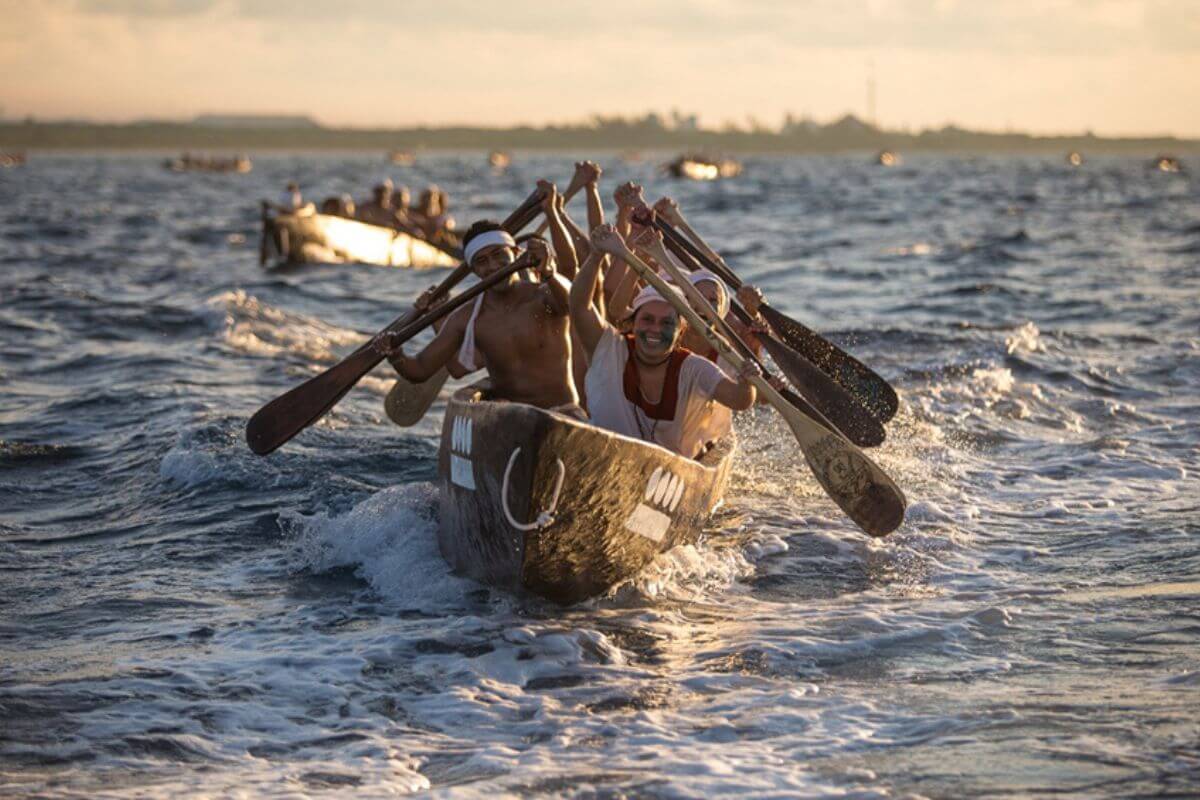
Each of the chosen participants will embark on a grueling regimen that includes long-distance swimming, canoe handling, and endurance exercises designed to mimic the strenuous nature of the historical voyage. This physical preparation ensures that participants can handle the challenging paddle across open ocean waters from Xcaret Park to Cozumel and back again, a distance of over 60 kilometers.
This journey tests not only physical strength but also mental endurance, requiring the canoeros to work together – not just as a team – but as one. Participants engage in team-building activities that foster trust and collaboration, crucial for navigating the unpredictable sea conditions they will face.
Spiritually, the participants partake in various Mayan rituals, blessings and cleansing ceremonies to better connect them with the ancient roots of the pilgrimage, helping to instill a sense of purpose and respect for the cultural significance of their journey.
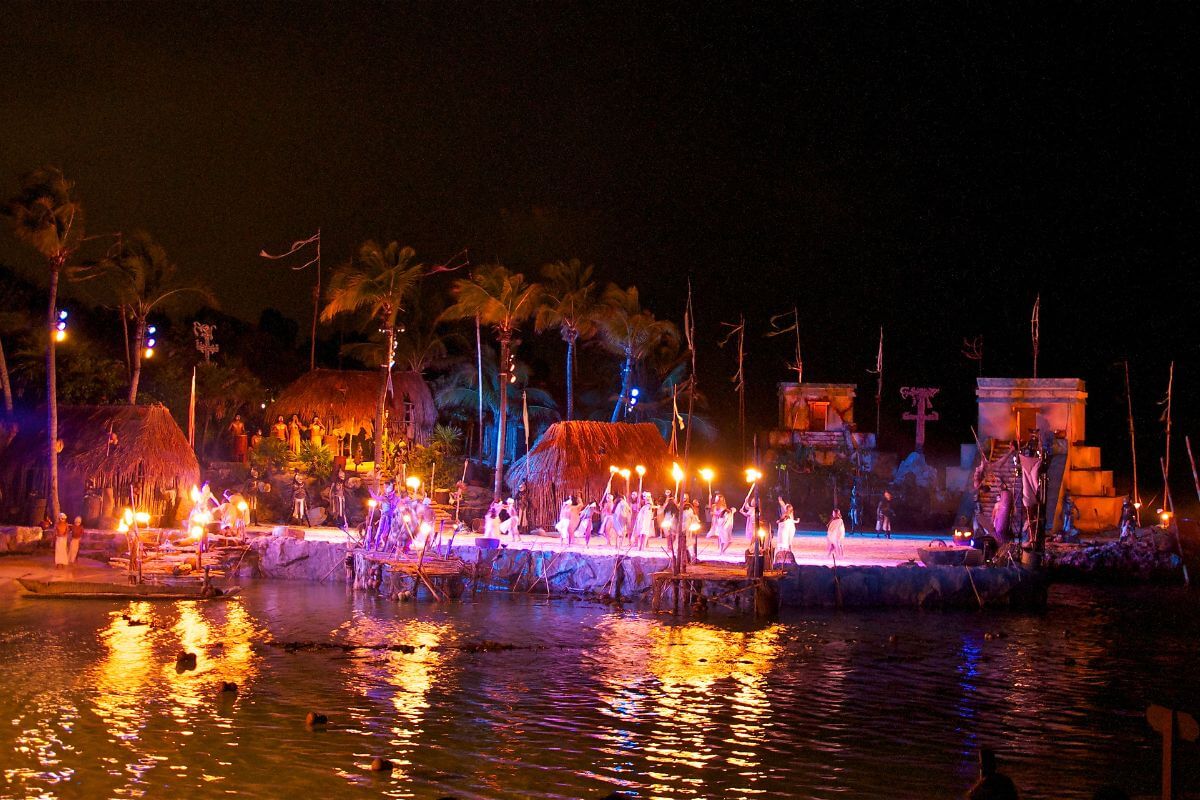
The community aspect of the training is particularly vibrant, as it draws together people from diverse backgrounds, united by a common goal to relive and honor a sacred Mayan tradition. This amalgamation of cultures not only enriches the experience but also strengthens communal ties and broadens the participants’ appreciation of Mayan cultural heritage. The training period serves as a profound period of personal growth and communal bonding, setting the stage for a transformative experience.
The Journey Itself
The Travesía Sagrada Maya commences at dawn, with canoeros and spectators gathering at Xcaret before first light to witness the first rays of the sun. As the eastern sky begins to brighten, the air fills with the scent of copal and the sound of Mayan conch horns, marking the start of the sacred journey. The rowers then board their canoes, embarking on the rigorous 35-kilometer crossing to Cozumel. The energy in the air is palpable as the first canoe breaks from the cove into the open sea. Depending on weather and water conditions, the trip can take from five to eight hours to complete.

Upon arrival to the shores of the bay on Cozumel, the brave canoers are met by throngs of loved ones and curious onlookers who have gathered in Parque Chankanaab, excited to catch a glimpse of the canoes as they appear on the horizon and paddle to the safety of the cove. Soaked in saltwater, sweat and tears, the canoeros will engage in a series of ancient rituals paying homage to the prehispanic diety through her oracle. These rituals, deeply symbolic and reflective of those performed by ancient Mayan pilgrims, include offerings and prayers at the ancient site dedicated to Ixchel.

The following day, the return journey challenges the brave canoers to muster the same strength and teamwork that carried them safely to the island, reaffirming their bonds and shared commitment. Their arrival back at Xcaret is met with great fanfare. The sound of conch horns announcing their arrival and a flock of colorful Guacamayas is released to guide them safely back into the bay of P’olé. It is not only an amazing spectacle but an extremely emotional experience for both the canoeros and their families who have been waiting for their safe return.
Cultural and Spiritual Significance
The rituals and ceremonies of the Travesia Sagrada Maya are vibrant threads woven into the fabric of Mayan spiritual life. On the day of the crossing, the area around the departure points on the bay is transformed into a bustling Maya market representing how it must have looked in ancient times when it was the important trade center, Polé.

Xcaret Park sets up special cultural exhibits educating visitors about the daily life and ancient rituals of the Maya culture. Engaging in these practices, participants experience a sense of continuity with the past that is both enlightening and transformative. These rituals foster a deeper connection with Mayan spirituality, immersing participants in the rituals and cycles central to Mayan life.
This profound engagement with ancient tradition enriches each participant’s understanding of their own resilience and spirituality, appealing to both locals and global visitors drawn to the mystical allure of ancient traditions. The Travesía Sagrada Maya serves not only as a cultural spectacle but as a vital link preserving the spiritual and communal practices of the ancient Maya, ensuring their relevance and resonance in today’s world.
La Travesia Sagrada Maya 2024
The theme of the 2024 Travesia Sagrada Maya will focus on reinforcing the sacred connection between humanity and nature, highlighting the worship of the Goddess Ixchel and Ixchebelyax, central figures in the Mayan cosmovision that symbolize youth and wisdom.

The 2024 Sacred Mayan Crossing is scheduled for May 17 and 18. 348 rowers will participate this year, on the 16th reenactment of this ancient crossing. They are all Quintana Roo residents but many hail from different parts of Mexico and all over the world. These brave canoers have rigorously prepared for more than six months for this challenge.
As they have done nearly every year since 2006, participants will emulate the trade and religious routes of the ancient Maya, departing from the site of P’ole to the island of Cozumel. This year’s edition of this iconic cultural event focuses on reinforcing the sacred connection between humanity and nature, highlighting the worship of the Goddess Ixchel and Ixchebelyax, central figures in the Mayan cosmovision that symbolize youth and wisdom.
This year’s cultural performance is entitled “Brujos de Agua” (Sorcerers of the Sea). It will be a spectacular recreation of rituals and dances that celebrate and honor the legacy of the Mayan ancestors. Participants will make offerings of elote (corn) and an ancient Mayan drink called Balché, essential elements in ancient Maya rituals.
In a press release, Leticia Aguerrebere, corporate director of Arts and Culture of Grupo Xcaret, expressed her satisfaction with the continuation of this event. “We are very happy to be able to carry out for the sixteenth consecutive year the Sacred Mayan Journey, which has achieved a strong union between the community and this cultural and artistic recreation, becoming a tradition that for many is the main event of the year in their lives.”

As president of Grupo Xcaret’s Cultural Heritage Committee, Aguerrebere emphasized the organization’s commitment to the recognition and preservation of the Maya cultural heritage. “The safeguarding of cultural heritage is a task that allows us to continue to constantly maintain actions such as research, preservation, protection, visualization, valuation, revitalization, dissemination and transmission of pre-Hispanic culture.”
The event will be attended by important figures such as the Halach Uinic of Cozume, a dignitary from Oxtankah-Ichpaatun, highlighting the importance of this celebration in today’s community. If you would like to attend the event on either day and witness this remarkable event, tickets are available both at Xcaret and at the Museo de la Isla on Cozumel. The FAQs and ticketing information can be found here.
How to Participate in the Next Travesía Sagrada Maya
Participating as a canoero in the Travesia Sagrada Maya offers a unique opportunity to immerse yourself in a profound cultural and spiritual experience. If you’re interested in being part of this sacred journey, the process is straightforward but requires commitment. Registration typically opens several months before the event and can be completed through the official Travesía Sagrada Maya website. Prospective participants must fill out an application form and submit it for the selection process. The number of paddlers is limited to ensure safety and maintain the integrity of the experience.

Once accepted, participants must undergo a comprehensive training program, which includes physical conditioning, canoe handling, and learning the ceremonial aspects of the journey. There are three training centers on the mainland, Cancun, Xcaret and Xel Ha and one on Cozumel. The training includes hundreds of hours of paddling including a special trip leaving from Cancun and paddling all the way around Isla Mujeres! The hours of training are brutal but crucial, as this prepares the canoeros for the demanding and dangerous paddle across the channel to Cozumel and back.
For detailed registration timelines, training schedules, and participation fees, visit the official Travesía Sagrada Maya website. Here, you can also find information about the necessary equipment and advice on how to prepare for the physical and spiritual challenges of the pilgrimage. This site is your primary resource for all updates and preparations needed to embark on this unforgettable adventure.
Author’s Note
In 2017, I was one of the lucky souls chosen to participate in this iconic cultural event. On May 25, 2018, 377 canoeros (including yours truly) celebrated the culmination of a grueling 6-month training regime and embarked on an iconic journey back in time.

I haven’t written about my personal experience with the Travesía. It was so emotionally transformative and I’ve never been able to find the right words. I undertook the Travesia at a point in my life that was tumultuous and uncertain. I really wasn’t sure I would be able to mentally survive the training, much less the actual crossing. I worried that my uncertainty and instability might put my fellow team members at risk. With the encouragement of friends and my fellow canoeros, I was able to push through the pain and complete what would be a life-changing journey.
For me, the Travesia Sagrada Maya was a one-in-a-lifetime experience and one that I credit with saving me when I needed saving. It reminded me that am strong and brave and capable of anything I put my mind to. To date, the Travesia Sagrada Maya remains the single most significant thing I have ever done for just myself.
